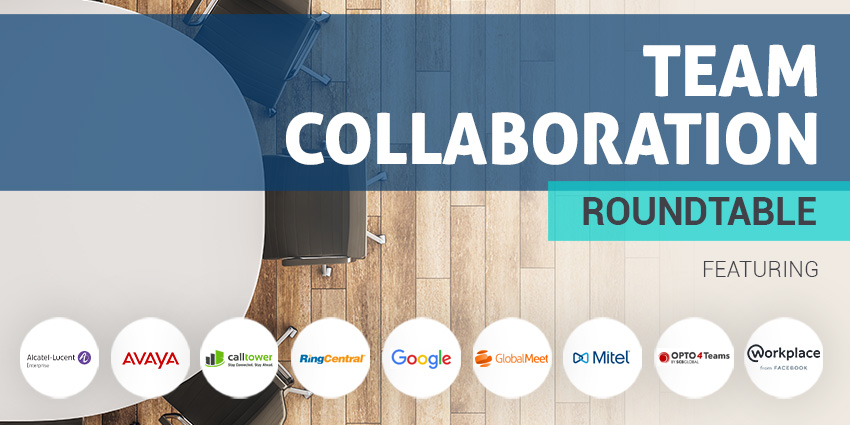It’s no secret that team collaboration is at the heart of most business success stories.
However, the way that people work together today isn’t the same as it used to be. The digital landscape and the rise of remote working has changed the office space as we know it. Instead of board-rooms and standup meetings, we have video conferencing and instant messaging.
In place of email and complex calls, we have file sharing and screen sharing. Team collaboration software is at the heart of workplace communication. It’s no wonder that the global team collaboration software market achieved a value of 9.5 billion in 2019.
With COVID-19 pushing even more companies to leave the old ways of work behind, it seems clear that team collaboration tools aren’t going anywhere. We spoke to leaders from the following brands to give you an insight into the future of Team collaboration:
- Alcatel-Lucent Enterprise
- Avaya
- CallTower
- SCB Global
- RingCentral
- PGi
- Mitel
- Workplace from Facebook
Let’s see what all of these amazing companies had to say.
What is the Biggest Challenge Faced by Business Regarding Team Collaboration?
Team collaboration tools have a lot to offer the modern business landscape. These unique pieces of software are faster and more efficient than waiting around for an email to load. What’s more, you can communicate in a variety of different ways, from video conferencing, to instant messaging. Studies show that team collaboration services improve productivity by up to 30%.
However, just like any new technology in business, collaboration tools come with challenges too. Companies need to figure out how to encourage adoption, side-step security issues, and address other hurdles. Here’s what our experts defined as the biggest challenge faced by Businesses in Team Collaboration.
 Matteo Kotch, Solution Marketing Manager of Alcatel-Lucent Enterprise:
Matteo Kotch, Solution Marketing Manager of Alcatel-Lucent Enterprise:
Alcatel-Lucent Enterprise’s Matteo Kotch said the biggest challenge for most companies recently came from the massive impact of the COVID-19 pandemic. “Seemingly overnight, businesses needed to put in place new processes, policies, and technologies to safeguard employees while simultaneously remaining operational. Cloud-based Unified communication and collaboration platforms became the go-to technology in most businesses continuity initiatives as they became widely regarded as the key to facilitating continued engagement between increasingly dispersed stakeholders.”
Kotch noted that even as the world began to settle down following COVID-19, businesses still needed to think about what kind of tools they would continue to leverage. Organisations in the modern landscape need collaboration tools not just in crisis situations, but all the time. “Businesses will need to continue relying on these UC&C as a Service platforms and refining the way their workforces leverage them.”
Rob Carmichael, Collaboration Specialist at Avaya:
Avaya’s Rob Carmichael told us that businesses have a lot of challenges to consider when they’re deciding which tools to use, and which services to explore.
“Often, the services a business has today are challenged in two different ways: Either the experience is simple but limited to conferencing only and is likely to have some security issues or the collaboration side is more developed, but the video experience is limited, and you can only access it via an expensive subscription.”
Avaya and Rob Carmichael believe that great collaboration can only happen when businesses have the right balance between usability, and security.
 William Rubio, CRO of CallTower:
William Rubio, CRO of CallTower:
CRO of CallTower, William Rubio told us that the largest obstacles that companies currently face regarding team collaboration were created by the fast onset of COVID-19. Like Alcatel-Lucent Enterprise, CallTower believes that the sudden shift to cloud put businesses under a lot of pressure.
“Over the past few months, during the stressful and extraordinary challenges of the COVID-19 pandemic, CallTower has been working hard to enable businesses can communicate and collaborate. As a critical component of emergency business continuity, communication is more important than ever in keeping companies operational.”
According to Rubio, CallTower has done everything it could to support businesses through the challenges that COVID-19 created.
Nick Riggott, Head of Sales UK, and Ireland at Mitel:
Mitel’s Nick Riggott said that in the early stages of the crisis, businesses were rushing to get set-up for remote working practices. However, it’s clear that working from home is likely to continue as a practice for quite some time.
“Now the challenge lies in ensuring what was put in place can work long term and integrates well into the broader infrastructure.”
“Without a consistent and comprehensive strategy, businesses may see a rise in shadow IT, meaning security risks and reduced efficiency”
Mitel believes that CIOs need to start thinking about their long-term communications and collaboration strategies and make technical choices that support consistent and secure communications. Organisations will need to move beyond the “temporary” solutions they have in place.
 Terry Lyons, VP of Product at PGi:
Terry Lyons, VP of Product at PGi:
VP of Product at PGi, Terry Lyons notes that ensuring people and teams can continue to connect reliably and safely with anyone around the world will be essential going forward. Like many other businesses, PGi sees that we’re moving into the era of the “new normal”, where at home workers are more common.
Businesses need to figure out how to support the shift to home working. “Right now, the @Home worker has a laptop, a mobile phone, maybe a strong internet connection and whatever consumer technology exists in their house. Ensuring engagement and productivity is a challenge. The demand for video and sharing functionality has surged and allowing users to personalise their experience is key. With the lack of social engagement, a person’s working environment has become the new social.”
Lyons said that from an IT perspective, supporting remote employees will bring new challenges, such as ensuring data is properly encrypted and protected.
Sunny Dhami, Senior Director of Product Marketing and GTM at RingCentral:
The Product Marketing and GTM Senior Director for RingCentral, Sunny Dhami noted that we’re in an exciting period right now. Lockdown restrictions are easing, and people are coming out of isolation. This means companies are figuring out how to continue after scrambling into work-from-home mode at a rapid pace.
“Now we’ve seen undeniably how remote work can work, how will that influence our expectations as employees and our policies as operations managers?”
“I think meeting employees’ expectations, and keeping workforces connected and collaborative in the long term, is a future-defining moment for businesses”
Dhami told us that there are going to be a lot of changes going forward in the way that we view productivity, including the when, how, and whys of the workforce.
 Shams Kahn, Principal Solutions Consultant at SCB Global:
Shams Kahn, Principal Solutions Consultant at SCB Global:
SCB Global’s Shams Kahn said that the rise of globalization and digitalisation has led to multiple silos in team collaboration, impacting user experience, teams experience and efficiency. With the new normal of remote work coming closer, companies need to figure out how to improve productivity and battle against distractions.
SCB Global believe that new challenges will emerge in the form of peaks and troughs in motivation due to lockdown or the “new normal” situation never seen/experienced before.
“Technical issues may prevent some employees from getting their work done, logging in to a specific technology or jumping multitudes of applications in a business day – using all features of virtual meetings, workshops, or labs tools”
Another issue might be a rise of cabin fever from people spending too much time at home. If team members can’t connect directly with colleagues, they may feel less engaged and productive. Some employees will struggle with the shift.
Julien Lesaicherre, Global Director and Director of Customer Success at Workplace from Facebook:
According to Julien Lesaicherre from Workplace from Facebook, as companies become more distributed and global, a big obstacle is going to be the issue of location. Many team members sitting in different countries or offices are left at a disadvantage with less visibility.
“Another growing collaboration challenge is volume of information. How do we separate what’s urgent from what’s not? How do we keep information safe that might be valuable later but not right now? And amongst all that noise, how can we focus our team on what will have impact?”
Julien said that what we’ve all seen with the COVID-19 pandemic is that remote work does have challenges. People will need to have the right strategy in place if they’re going to deal with increased volumes of remote workers in the future.
 Patrick Wynn, Lead Product Manager at Google Voice:
Patrick Wynn, Lead Product Manager at Google Voice:
Lead Product Manager for Google Voice, Patrick Wynn told us that there are a lot of great team collaboration tools available today. Having access to the right tools therefore isn’t a challenge. Having too many tools, however, can be a problem.
“A team is defined as a group of individuals working together, so when people use different tools to collaborate amongst each other, the togetherness is lost and can result in poor productivity. A key challenge of working with others is the barrier to entry.”
Patrick says that teams will need to determine whether collaborators need to install something or sign into a tool to use it, and how this will affect adoption. It may also be worth thinking about whether collaborators need to use separate workflows, or whether everything is integrated with what they’re already using. “User preference will play a strong role, so it must be easy to use, reliable and manageable in real-time by IT.”
How can Team Collaboration software address the challenges?
So, with so many challenges to consider on the path to successful digital transformation in the workplace, what can team collaboration tools do? How can having the right service for video conferencing and instant messaging support companies in accomplishing their goals regarding growth and productivity?
Now that around 83% of professionals say that they need technology for proper collaboration, the demand for team collaboration tools will only increase. Here’s what our experts had to say about addressing challenges with team collaboration tools.

Matteo Kotch told us that in the last few months, team collaboration software has demonstrated just how valuable it can be. As we move into the era of the new normal, businesses will continue to rely on the technology their teams have begun to use. However, it’s likely that companies will need some capabilities more than others.
“Arguably the most obvious reliance will be on multiparty conferencing – audio and video – and its ability to support the phased-in approach businesses will take in their ‘return to the office’ initiatives.”
Kotch said that while employees will continue to rely on these features for an external meeting, conferencing may also become the new norm for people in the same office building too. This could help companies to maintain social distancing and follow new government requirements.
“Therefore, to accommodate this new challenge, most vendors have been working tirelessly on enhancing their audio and videoconferencing capabilities by making changes such as enhancing the number of audio and video streams and increasing the number of potential participants, while delivering an enterprise-grade SLA.”
Avaya’s Collaboration Specialist, Rob Carmichael said that today’s companies need to design their solution for collaboration from the ground up. Organisations need to ensure that their teams have the right solutions in place for video and audio, as well as instant messaging and presence. For the tools that teams use today to be successful, they need to offer security solutions too.
Avaya says that businesses need to look for a vendor that has a demonstrated history of taking security issues seriously. However, your service shouldn’t be tied to a costly subscription.
“Underlying technologies are also key, team collaboration services that allow your guests to access your meetings without installing any software are important to maintain security and to minimise the setup time needed to join a first call”

CallTower CRO, William Rubio says that team collaboration software enables workforces to communicate and work together at any place or time. Solutions like Direct Routing for Microsoft Teams by CallTower can enable that collaboration even further.
“As many companies continue to explore migration strategies for Microsoft Teams, we’re prepared to make the transition as smooth and ROI friendly as possible. We are actively migrating and on-boarding customers to Microsoft Teams Direct Routing every day. We’re thrilled to provide a Direct Routing solution that saves customers over 50% on their Teams solution, complete with custom integrations.”
Rubio believes that the key to good team collaboration is to make sure that employees can work from anywhere with complete reliability and security.
Nick Riggott, Head of Sales UK, and Ireland at Mitel:
According to Mitel’s Head of Sales, technology has an essential role to play in ensuring that team collaboration is efficient and productive while remaining consistent, secure, and flexible.
“At Mitel we work with hundreds of companies across the UK. Many of them had been adapting their business models to enable occasional remote working before Covid-19. But it’s taken this crisis to fully demonstrate the value technology can bring.”
Riggott noted that video conferencing technology, for example, has been around for a long time, but it wasn’t available for everyone. Now adoption is better for video than ever. Employees are collaborating in ways that they never could have in a physical office.
“The real test will be the next few months as more offices open and workers return. Businesses must learn from the experience and ensure technology is used to its fullest potential.”

PGi’s Terry Lyons believes that rich video, mobile, and sharing capabilities will bridge the gaps between office and home for the remote worker. Team collaboration software needs to offer a frictionless experience so that employees can communicate anywhere, on any device. This will help work to move more efficiently.
“Supporting the @Home worker with what they have at their disposal. Integrations to Virtual Assistants like Amazon Echo, using your mobile phone as a mobile sharing device.”
Solutions like these help to reduce the high amount of time spent orchestrating work, according to Lyons and increases the productivity in the workplace. Employees get to take back some of their day with smart collaboration and new innovative features. However, it’s essential for businesses to feel that collaborative conversations are secure.
According to RingCentral’s Sunny Dhami, one of the critical functions of a team collaboration solution is to ensure that people can work together seamlessly wherever they are. The cloud offers built-in continuity, and unlimited storage in this environment. What’s more, with team collaboration, cloud-based tools businesses get geographical independence.
“If your office has a power cut, you can still access all your tools and documents. If you have a vacancy, your candidate search isn’t restricted by the commute radius. If your sales team in Manchester needs support from your legal department in Oxford, they can have that instant input.”
According to Dhami, putting the right tools in place to empower employees to work how and when it suits them will lead to a more engaged workforce. This leads to lower retention issues and higher productivity.

SCB Global’s Shams Kahn notes that it’s essential to embrace a team collaboration platform today that breaks silos and offers more forms of interactions to teams. Businesses need an open and flexible platform that supports the option to integrate with productivity suite applications and other essential tools.
“Many businesses will be looking to employ a single team collaboration solutions strategy that can prevent app overload. These companies will also need the solution to feature appropriate training for staff and ease of adoption. Everyone needs to be familiar with the right technology and tools so that they can perform at their best.”
Workplace from Facebook notes that collaboration software has the potential to truly level the playing field. According to Julien, it ensures that everyone in a team has access to the same colleagues and information. “For this reason, we believe that such tools have the most impact when they’re adopted company-wide, are mobile and are easy to use. We regularly hear from customers that they’re able to bring new ideas to market by enabling collaboration across the workforce, from frontline to HQ.”
Additionally, Lesaicherre notes that when it comes to volume of communications, what the company knows is that some projects require instant collaboration chat or video. For others, it’s preferable to work asynchronously with colleagues. There’s also a requirement for a more static environment for information that everyone needs to refer back to.

According to Patrick Wynn, value comes from people, not the offices they work in or the tools that they use. Real people with unique motivations, work styles and ideas are at the heart of team work according to Google.
“Team Collaboration software is essentially the glue that brings people together allowing working as a team simpler. Collaboration was built into G Suite from the beginning, not bolted on at the end. In fact, more than 70% of the time people spend in Google Docs is actually collaborating with others.”
Wynn says that G-Suite’s human-focused approach makes work easier and more fun, so that people can work together to accomplish more.
“If the software can delight users and have everyone working and collaborating together, that is when businesses will see real value”
How will AI positively impact Team Collaboration and businesses employing the technology?
Finally, we were keen to learn from our collaboration experts how disruptive new technology like artificial intelligence will play a part in changing the way that we collaborate. Artificial Intelligence is rapidly making an impact on all parts of the communication landscape, from contact centres to unified communication tools.
In the collaboration space, AI is becoming an increasingly exciting tool for things like inline transcription and translation, or even automation. Here’s what our experts had to say about the rise of artificial intelligence in team collaboration technology.
Alcatel-Lucent Enterprise noted that artificial intelligence is increasingly making more of an impact on the modern workplace. Whether it’s through natural language processing or automation systems for customer service, AI is everywhere.
“By 2035, it is expected that there will be a 40% increase in labour productivity due to AI. When it comes to team collaboration platforms, the influence of AI is equally as prevalent”
“Many vendors are looking to it to help augment their offerings and develop unique selling points that differentiate them from other platforms.”
For instance, when it comes to remote meetings and video conferencing, AI can be used to reduce preparation times and add structure to meetings. AI can also transcribe meetings with detailed action points for each participant and make sure that the right follow-up happens.

Rob Carmichael says that AI and services related to it will be essential to unlocking additional productivity benefits available with Team Collaboration tools.
“Ideas like an automatic transcription of meeting notes that are then available to all participants with specific named people automatically tagged for specific actions. Automatically inferring and suggesting actions from analysing the dialogue that has been transcribed as well.”
Avaya believes that suggestions of key people that might be necessary for a new project when you create a team space might be possible in the future. AI could also help with automatically creating agendas and suggesting shorter meeting times when meeting efficiency increases.
“While UCaaS and Collaboration solutions deliver the collaboration that is essential in most work areas, including remote workers. Noise is a constant factor. Our turnkey solutions deliver secure endpoints with noise cancelling benefits”
Rubio also told us that CallTower was the first solution provider to deliver a solution that was integrated with Microsoft Teams and delivered global calling plans. CallTower is a Microsoft Gold partner with management and monitoring services that deliver the highest quality of user experience.
“The Microsoft Teams Phone System powered by CallTower enables customers to bring their current voice serves into the Microsoft Cloud through Direct Routing.”
According to CallTower, direct routing ensures that clients can leverage preferred rates through CallTower, while taking full advantage of the benefits of Microsoft Teams for UCaaS functionality.

Mitel’s Nick Riggott said that AI has a lot of potential to lighten the burden for people working on the front lines of customer service. In contact centres, for instance, AI has a lot to offer. “One example of this is Mitel’s partnership with Google Cloud Contact Center AI, which allows businesses to use virtual agents alongside humans in contact center environments. This isn’t about replacing people: there will always be a place for human agents, especially in times like these where many people are facing complex situations that require expertise, empathy, and understanding.”
Riggott noted that as we look towards the future of team collaboration and AI, virtual agents and chat functionality with intelligent components could do a lot for front-line agents. They could also help to reduce wait times and help customers get better experiences.
PGI told us that AI will help to power connections in a very powerful way in the team collaboration space. AI can help to suggest and make connections between people and groups based on questions, queries, and searches; additionally, it could give teams the option to access meeting summaries and suggested action items quicker too.
AI will create time for people to gain more productivity according to PGI, particularly when tools are integrated with relevant workspaces. “Smart actions are also an option to provide a better collaboration experience. Noise cancellation on audio, mute detection suggestions, and keyword notifications (if someone mentions a topic in your keyword list or your name, you get a notification and maybe an excerpt from the meeting transcript.”
PGi also noted that powerful analytics would be an essential benefit of AI in the team collaboration space too.

Sunny Dhami said that AI could mean incredible things for business productivity. In the marketplace we currently share, the value proposition that humans have is the ability to apply cognitive skills to tasks and challenges. However, as AI takes over routine and low-cognitive tasks, this means that teams can focus more of their creative energy elsewhere.
“Virtual assistants, that can lighten the administrative load for their users are a great example of this. One of the high barriers to adoption of tools in the workplace is their ease of use. People usually have to adapt to collaborative tools – but improvements in the application of AI can reverse that, making it possible for technology to adapt to people. That creates the potential for truly people-centred digital transformation.”
According to Shams Kahn, AI tools can be used before, during, and after collaboration sessions and meetings to save time and improve productivity. AI tech can support the suppression of background noise in a conversation and improve experiences. Tech can also remove some of the trivial tasks involved in collaboration, like booking a meeting or adding notes to a file after a session.
“With AI, companies can transcribe calls and capture important details in a call that would otherwise be missed. Systems can spot keywords to pick out essential details from a conversation and ensure effective follow-up. There are even options with sentiment analysis to create better customer experience reports too.”

Workplace from Facebook told us that AI would play a powerful role in the role of the future of work. Already, this technology is making a massive difference to the way that people collaborate. For instance, AI and bots are augmenting the way that many people work, taking care of things like scheduling and note-taking on behalf of human beings.
“This means that everyone can focus on the projects that will have the biggest impact, rather than the repetitive processes that slow things down.”
Julien said that AI also has an impact on collaboration tools by ensuring that employees get access to content that’s most relevant to their needs. At Workplace, the software automatically surfaces the most relevant and useful information to people on their newsfeed, using the intelligent algorithms that are similar to those in Facebook consumer products.
“Finally, AI has a role to play in supporting inclusivity. With tools like automatic translations and captioning, organisations can give employees access to the same information, regardless of language or disability”
Google Voice’s Patrick Wynn believes that AI has a lot to offer in the collaboration environment. He said that according to McKinsey and Company, businesses that make the most of AI technology can double their cash flow by 2030. On the other hand, businesses that don’t use these tools could see a decline in revenue by around 20%.
“Team Collaboration is about helping people work together to reach a successful outcome so leveraging AI with Machine Learning (ML) to gather information, find common patterns and solve problems can assist to achieve those outcomes sooner. AI has been embedded into G Suite from the onset, just look at the spam detection AI filter in Gmail, it stops more than 10 million spam messages from getting through every minute.”
Patrick says that another way AI helps team collaboration is by suggesting meeting participants, setting schedules, and ensuring that everyone can be available at a certain time for a meeting. Voice commands to start meetings and closed captions may be helpful too. “De-noising for more efficient meetings and voicemail transcription for Voice calls. You’ll find AI in almost every product in G Suite with much more to come.”







